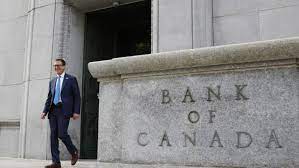At its meeting on Wednesday, the Bank of Canada is anticipated to accept the unexpected recent economic strength and hold interest rates steady, betting on a slowdown in activity as higher borrowing costs take effect.
After raising its benchmark rate to a 15-year high of 4.50% last month, the Bank of Canada made history by becoming the first significant central bank in the world to halt its rate-hiking campaign. It declared that if the economy slowed or even entered a minor recession as expected, no additional tightening would be required.
Even if inflation has decreased recently, other economic data show that the economy is recovering from a weak fourth quarter.
Following a stronger-than-expected 0.5% advance in January, preliminary statistics released last week revealed that the gross domestic product (GDP) increased by 0.3% month over month in February. March’s employment statistics revealed a seventh straight month of job growth.
According to James Orlando, a senior economist at TD Economics, “The economy is exhibiting renewed impetus; with more people working and seeing their salaries improve.” “They’re out shopping once more. This will result in faster economic expansion.”
Most people find it to be good news, but Bank of Canada (BoC) Governor Tiff Macklem does not, as it would cast doubt on his decision to declare a conditional rate halt in January.
After receiving criticism for moving too slowly to control inflation, which shot up after pandemic limitations were released, Macklem is attempting to regain the confidence of the public. The central bank has acknowledged that it first miscalculated the pressures on prices.
The current budget presented by Prime Minister Justin Trudeau, which includes billions in new spending, may make that task more difficult.
WORRIED, BUT HOPEFUL.
Due to February’s unexpectedly good numbers, analysts have revised their predictions of GDP upward. According to a survey of six economists, the median first-quarter growth estimate is 2.5%, which is much higher than the BoC’s forecast of 0.5%.
Orlando stated, “For the BoC, we still anticipate a hold.” They will probably be worried about the recovery in economic activity, but we believe they are still optimistic about a slowdown for the rest of 2023.
The BoC will hold its benchmark overnight rate constant on Wednesday when it releases its next set of policy announcements, according to all 33 analysts surveyed. The central bank will make a cut as its next move, according to the money markets.
Investors argue that the full effects of increasing borrowing costs have not yet been felt. Also, recent stress in the global banking system has increased investor worries about a credit crunch, which might affect the US as well. 75% of Canada’s exports go to its southern neighbor.
According to Andrew Grantham, a senior economist at CIBC Capital Markets, “We envisage growth being driven mostly by an easing of earlier supply limitations… rather than a big rise in domestic demand.”
We anticipate that the Bank of Canada will assess the first-quarter GDP’s apparent strength similarly and raise its forecast of future growth.
A rise in the expected level could lessen the need for a hawkish shift from the central bank because potential growth is the rate at which activity in the economy can increase without leading to inflation.
According to economists, Canada’s potential growth, which was most recently predicted by the BoC to be 2.25% on average over 2023 and 2024, may be increased by both rapid population growth and fewer supply chain disruptions.
According to Nathan Janzen, assistant chief economist at the Royal Bank of Canada, Canada’s economy is facing challenges from rising borrowing prices and worries about the soundness of the banking system. At the same time, inflation has decreased more than in the US.
Hence, Janzen added, “There are still compelling arguments on both sides for the BoC to maintain a wait-and-see stance for the time being.”


















